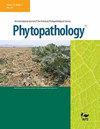Kathleen Kanaley, David B Combs, Angela Paul, Yu Jiang, Terry Bates, Kaitlin M Gold
求助PDF
{"title":"评估高分辨率商业卫星图像在纽约州葡萄霜霉病检测和监控方面的能力。","authors":"Kathleen Kanaley, David B Combs, Angela Paul, Yu Jiang, Terry Bates, Kaitlin M Gold","doi":"10.1094/PHYTO-11-23-0432-R","DOIUrl":null,"url":null,"abstract":"<p><p>Grapevine downy mildew (GDM), caused by the oomycete <i>Plasmopara viticola</i>, can cause 100% yield loss and vine death under conducive conditions. High-resolution multispectral satellite platforms offer the opportunity to track rapidly spreading diseases such as GDM over large, heterogeneous fields. Here, we investigated the capacity of PlanetScope (3 m) and SkySat (50 cm) imagery for season-long GDM detection and surveillance. A team of trained scouts rated GDM severity and incidence at a research vineyard in Geneva, New York, from June to August 2020, 2021, and 2022. Satellite imagery acquired within 72 h of scouting was processed to extract single-band reflectance and vegetation indices (VIs). Random forest models trained on spectral bands and VIs from both image datasets could classify areas of high and low GDM incidence and severity with maximum accuracies of 0.85 (SkySat) and 0.92 (PlanetScope). However, we did not observe significant differences between VIs of high and low damage classes until late July to early August. We identified cloud cover, image co-registration, and low spectral resolution as key challenges to operationalizing satellite-based GDM surveillance. This work establishes the capacity of spaceborne multispectral sensors to detect late-stage GDM and outlines steps toward incorporating satellite remote sensing in grapevine disease surveillance systems. [Formula: see text] Copyright © 2024 The Author(s). This is an open access article distributed under the CC BY-NC-ND 4.0 International license.</p>","PeriodicalId":20410,"journal":{"name":"Phytopathology","volume":" ","pages":"2536-2545"},"PeriodicalIF":2.6000,"publicationDate":"2024-12-01","publicationTypes":"Journal Article","fieldsOfStudy":null,"isOpenAccess":false,"openAccessPdf":"","citationCount":"0","resultStr":"{\"title\":\"Assessing the Capacity of High-Resolution Commercial Satellite Imagery for Grapevine Downy Mildew Detection and Surveillance in New York State.\",\"authors\":\"Kathleen Kanaley, David B Combs, Angela Paul, Yu Jiang, Terry Bates, Kaitlin M Gold\",\"doi\":\"10.1094/PHYTO-11-23-0432-R\",\"DOIUrl\":null,\"url\":null,\"abstract\":\"<p><p>Grapevine downy mildew (GDM), caused by the oomycete <i>Plasmopara viticola</i>, can cause 100% yield loss and vine death under conducive conditions. High-resolution multispectral satellite platforms offer the opportunity to track rapidly spreading diseases such as GDM over large, heterogeneous fields. Here, we investigated the capacity of PlanetScope (3 m) and SkySat (50 cm) imagery for season-long GDM detection and surveillance. A team of trained scouts rated GDM severity and incidence at a research vineyard in Geneva, New York, from June to August 2020, 2021, and 2022. Satellite imagery acquired within 72 h of scouting was processed to extract single-band reflectance and vegetation indices (VIs). Random forest models trained on spectral bands and VIs from both image datasets could classify areas of high and low GDM incidence and severity with maximum accuracies of 0.85 (SkySat) and 0.92 (PlanetScope). However, we did not observe significant differences between VIs of high and low damage classes until late July to early August. We identified cloud cover, image co-registration, and low spectral resolution as key challenges to operationalizing satellite-based GDM surveillance. This work establishes the capacity of spaceborne multispectral sensors to detect late-stage GDM and outlines steps toward incorporating satellite remote sensing in grapevine disease surveillance systems. [Formula: see text] Copyright © 2024 The Author(s). This is an open access article distributed under the CC BY-NC-ND 4.0 International license.</p>\",\"PeriodicalId\":20410,\"journal\":{\"name\":\"Phytopathology\",\"volume\":\" \",\"pages\":\"2536-2545\"},\"PeriodicalIF\":2.6000,\"publicationDate\":\"2024-12-01\",\"publicationTypes\":\"Journal Article\",\"fieldsOfStudy\":null,\"isOpenAccess\":false,\"openAccessPdf\":\"\",\"citationCount\":\"0\",\"resultStr\":null,\"platform\":\"Semanticscholar\",\"paperid\":null,\"PeriodicalName\":\"Phytopathology\",\"FirstCategoryId\":\"97\",\"ListUrlMain\":\"https://doi.org/10.1094/PHYTO-11-23-0432-R\",\"RegionNum\":2,\"RegionCategory\":\"农林科学\",\"ArticlePicture\":[],\"TitleCN\":null,\"AbstractTextCN\":null,\"PMCID\":null,\"EPubDate\":\"2024/12/19 0:00:00\",\"PubModel\":\"Epub\",\"JCR\":\"Q2\",\"JCRName\":\"PLANT SCIENCES\",\"Score\":null,\"Total\":0}","platform":"Semanticscholar","paperid":null,"PeriodicalName":"Phytopathology","FirstCategoryId":"97","ListUrlMain":"https://doi.org/10.1094/PHYTO-11-23-0432-R","RegionNum":2,"RegionCategory":"农林科学","ArticlePicture":[],"TitleCN":null,"AbstractTextCN":null,"PMCID":null,"EPubDate":"2024/12/19 0:00:00","PubModel":"Epub","JCR":"Q2","JCRName":"PLANT SCIENCES","Score":null,"Total":0}
引用次数: 0
引用
批量引用

 求助内容:
求助内容: 应助结果提醒方式:
应助结果提醒方式:


